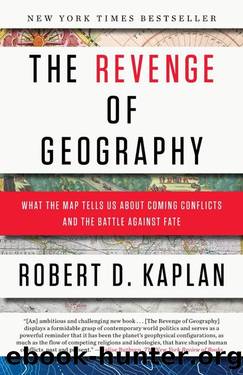The Revenge of Geography: What the Map Tells Us About Coming Conflicts and the Battle Against Fate by Kaplan Robert D

Author:Kaplan, Robert D. [Kaplan, Robert D.]
Language: eng
Format: epub
Tags: Political Science, International Relations, General, History, Historical Geography, Social Science, Human Geography
ISBN: 9780679604839
Google: njs-hFHxR2sC
Publisher: Random House Publishing Group
Published: 2012-09-11T17:32:18.929501+00:00
To download a printable version of Map 5, click here: http://rhlink.com/rg005
Whereas the âneatâ sequence of forest, prairie, high desert, mountain, and coastâcrossed in the middle by the northâsouth flowing Mississippi and Missouri riversâdefines American geography, in China the great riversâthe Wei, Han, Yellow, and Yangziârun from west to east, from the high and dry uplands of the Eurasian interior to the moister agricultural lands closer to the Pacific coast.4 These agricultural lands are, in turn, divided between the comparatively dry wheat-millet area of northern China, with its short growing season, akin to the northern Midwest of America, and the wet, double-cropping rice culture of Chinaâs productive south. Thus, the building of the Grand Canal between 605 and 611, linking the Yellow and the Yangzi riversâand Chinaâs famine-prone north with its economically productive south, with its rice surplusesâhad, according to British historian John Keay, âa similar effect to the building of the first transcontinental railroads in North America.â5 The Grand Canal was the key to Chinese unity. For it eased the northâs conquest of the south during the medieval Tang and Song dynasties, which helped consolidate the core geography of agrarian China. Again, here we see how individual acts of menâthe building of a canalâprove more historically crucial than the simple fact of geography. For given the grave differences between northern and southern China, in the early medieval era the split between the two Chinas which had lasted for two centuries might well have become permanent, like that between the eastern and western Roman empires.6
But as the late Harvard professor John King Fairbank writes, âThe contrasts between North and South China are superficial compared with those between the pastoral nomadism of the plateaus of Inner Asia and the settled villages based on the intensive agriculture of China.â By Inner Asia, Fairbank means something quite comprehensive: âthe wide arc running from Manchuria through Mongolia and Turkestan to Tibet.â Chinaâs sense of itself, he goes on, is based on the cultural difference that obtains between this surrounding belt of desert and the sown of China proper, that is, between the pastoral and the arable.7 Chinaâs ethnic geography reflects this âcore-periphery structure,â with the core being the arable âcentral plainâ (zhongyuan) or âinner Chinaâ (neidi), and the periphery being the pastoral âfrontiersâ (bianjiang) or âouter Chinaâ (waidi).8
This is what the building of the Great Wall was ultimately about. The Great Wall, writes political scientist Jakub Grygiel, âserved to reinforce the ecological distinction that translated into political differences.â9 Indeed, to the early Chinese, agriculture meant civilization itself: the Central or Middle Kingdom, Zhongguo, which owed nothing to the surrounding pastoral peoples. From this followed the kind of cultural certainty that China would share with Western Christendom.10 From the late Zhou Dynasty in the third century B.C., arable China would begin to absorb barbarian and quasi-barbarian elements.11 And later, beginning with the Han Dynasty in the second century B.C., the Chinese would encounter other culturesâRoman, Byzantine, Persian, and Arabâand thus develop a comparative, regional sense of space.
Download
This site does not store any files on its server. We only index and link to content provided by other sites. Please contact the content providers to delete copyright contents if any and email us, we'll remove relevant links or contents immediately.
| Historic | Information Systems |
| Regional |
Man-made Catastrophes and Risk Information Concealment by Dmitry Chernov & Didier Sornette(4738)
The Revenge of Geography: What the Map Tells Us About Coming Conflicts and the Battle Against Fate by Kaplan Robert D(3600)
Zero Waste Home by Bea Johnson(3293)
COSMOS by Carl Sagan(2950)
In a Sunburned Country by Bill Bryson(2948)
Good by S. Walden(2916)
The Fate of Rome: Climate, Disease, and the End of an Empire (The Princeton History of the Ancient World) by Kyle Harper(2439)
Camino Island by John Grisham(2385)
A Wilder Time by William E. Glassley(2364)
Organic Mushroom Farming and Mycoremediation by Tradd Cotter(2308)
Human Dynamics Research in Smart and Connected Communities by Shih-Lung Shaw & Daniel Sui(2179)
The Ogre by Doug Scott(2115)
Energy Myths and Realities by Vaclav Smil(2061)
The Traveler's Gift by Andy Andrews(2012)
Inside the Middle East by Avi Melamed(1941)
Birds of New Guinea by Pratt Thane K.; Beehler Bruce M.; Anderton John C(1907)
Ultimate Navigation Manual by Lyle Brotherton(1768)
A History of Warfare by John Keegan(1718)
And the Band Played On by Randy Shilts(1615)
